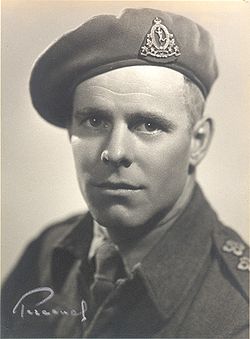Symington, James Alexander
| James Alexander Symington | |
|---|---|
| 23 June 1915 – 6 May 1945 | |
 | |
| Nickname | Jimmy |
| Place of birth | Winnipeg, Manitoba |
| Place of death | Germany |
| Place of burial | Holten Canadian War Cemetery |
| Allegiance | Canada |
| Service/branch | Canadian Army |
| Years of service | 1939-1945 |
| Rank | Captain |
Early Life
James (Jimmy) Alexander Symington was born on June 23, 1915 in Winnipeg Manitoba.[2] When he was 13 years old his family moved to Montreal. He was from a wealthy prominent Mount Royal family headed by a rich influential father, Herbert James Symington (1881-1965). Herbert Symington was a lawyer and businessman. He was a former Director of Canadian Pacific Railway and President of Trans Canada Airlines (1941-47). He was the founding president of the International Air Transport Association. Jimmy’s mother was Evelyn Fay (Christie) Symington (1882-1972). He had two sisters, Elizabeth Coristine, two years younger and Margaret Helen Eakin, two years older. The family were of Scottish origin and attended the Church of England. James spoke both French and English. He was a slender young man weighing 122 pounds and standing five feet six inches. He was in excellent physical shape with 20/20 vision.
He attended the prestigious Ashbury College in Ottawa, Ontario for six years graduating in 1933. While at Ashbury College he also was member of the Canadian Officer Training Corps (COTC) cadet program. He held the rank of Corporal. He won the Connaught Cup for gymnastics and won the senior skiing competition in 1933. Moreover, he was on the college cricket team. It was noted that he "was a natural hitter with a beautiful eye but has not yet learned the value of footwork." In addition, he was a member of the college’s senior football team as their quarterback. It was reported that he was “a most enterprising player who varied his signals with conspicuous success.” Another sport he played was the position of right wing on the college hockey team. It was reported that he was "a beautiful stickhandler with a very powerful shot." If that was not enough, he was won the Senior Lightweight title in the Ninth Annual Boxing Tournament.
After Ashbury College he attended for two years, from 1933-1935, Bishop's University in Sherbrooke, Quebec in their Arts course with a view to take Law but did not graduate. From September 1935 to March 1937 he was the assistant to the Chief Statistician at the Montreal Engineering Company, a public utility. In March 1937 he moved to Halifax, Nova Scotia and was employed with Nova Scotia Light and Power Company as a maintenance lineman until his enrollment in the Canadian Army.
Service
On 28 August 1939, at the age of 24, he enlisted with the Royal Canadian Corps of Signals as a Lineman at the rank of Signalman and started his service with No 6 Fortress Signal Company in Halifax, Nova Scotia. His service number was F28924. He progressed quickly through the ranks. Within a year he was promoted to Acting Sergeant on 13 August 1940. As an officer cadet he was posted to Officer Training Centre in Brockville, Ontario for training on April 1, 1941. On completion of his course and at the rank of Second Lieutenant, he was shipped to Vimy Barracks, Kingston Ontario on July 1, 1941. He was promoted to Lieutenant on October 17, 1941. At the end of January 1942, he attended the the six week Platoon weapons course at the Canadian Small Arms Training Centre in Long Branch, Ontario. He was posted to 2nd Army Tank Brigade Signal Section in Borden Ontario at the rank of Lieutenant on July 16, 1942. While there, he passed his vehicle operator and motorcycle course.
He left Camp Borden on June 14, 1943 to proceed on Special Duty overseas in the United Kingdom with 2nd Army Tank Brigade, reorganized as 2nd Canadian Armoured Brigade. The brigade was assigned to the British 2nd Army in January 1944 to train for amphibious assault as part of the Normandy landings on June 6, 1944. Lieutenant Symington was promoted to Acting Captain on 24 April 1944 and posted to 1st Line of Communication Signals the next day. From May 10, 1944 to July 24, 1944 he was attached to 2nd Line of Communications Signals before returning to 1st Line of Communications Signals, 5th Construction Section. Lieutenant Symington landed in France on June 18, 1944. On September 25, 1944 he was promoted to Captain. On February 25, 1945 he was attached to Headquarters First Canadian Army Signals until March 14, 1945.
He was killed on May 6, 1945 in Germany, one day after the surrender of the German Army. Captain Symington’s section was laying a line along a railway track at Bad Zwischenahn near Oldenburg, Germany. The countryside was heavily mined. Captain Symington and his Sergeant were reconnoitering in a jeep the side roads leading to the railway line when the jeep hit a mine. Captain Symington was killed by the blast and death was instantaneous. He was buried the next day in Apen Germany. Later in September 1946 his remains were reburied at the Holten Canadian War Cemetery in Overrijssel, Netherlands. He is buried at Grave 15, row C, plot 11.




